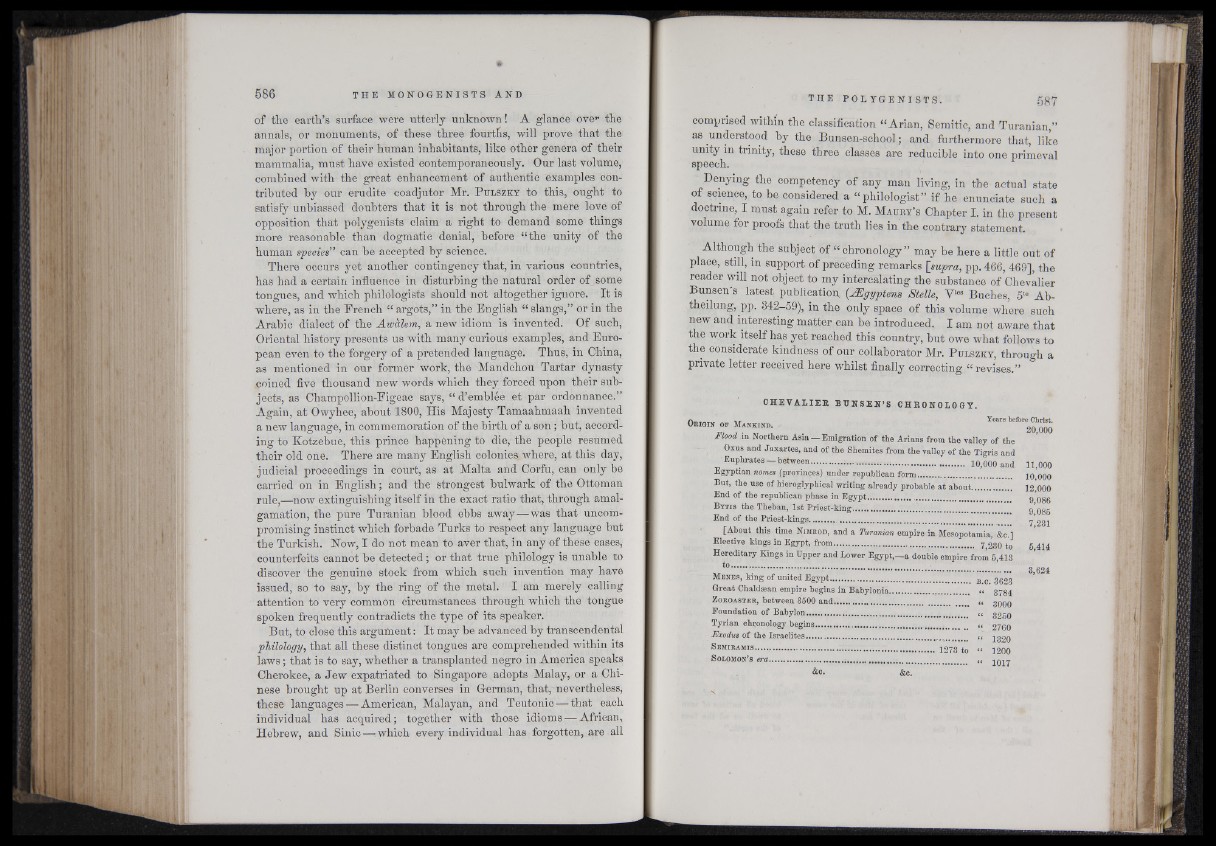
of the earth’s surface were utterly unknown ! A glance ove*1 the
annals, or monuments, of these three fourths, will prove that the
major portion of their human inhabitants, like other genera of their
mammalia, must have existed contemporaneously. Our last volume,
combined with the great enhancement of authentic examples contributed
by our erudite coadjutor Mr. P ulszky to this, ought to
satisfy unbiassed doubters that it is not through the mere love of
opposition that polygenists claim a right to demand some things
more reasonable than dogmatic denial, before “ the unity of the
human species’’ can he accepted by science.
There occurs yet another contingency that, in various countries,
has had a certain influence in disturbing the natural order of .some
tongues, and w;hich philologists should not altogether ignore. It is
where, as in the French “ argots,” in the English “ slangs,” or in the
Arabic dialect of the Awàlem, a new idiom is invented. Of such,
Oriental history presents us with many curious examples, and European
even to the forgery of a pretended language. Thus, in China,
as mentioned in our former work, the Mandchou Tartar dynasty
coined five thousand new words which they forced upon their subjects,
as Champollion-Figeae says, “ d’emblée et par ordonnance.”
Again, at Owyhee, about 1800, His Majesty Tamaahmaah invented
a new language, in commemoration of the birth of a son ; but, according
to Kotzebue, this prince happening to die, the people resumed
their old one. There are many English colonies where, at this day,
judicial proceedings in court, as at Malta and Corfu, can only be
carried on in English ; and the strongest bulwark of the Ottoman
rule;—now extinguishing itself in the exact ratio that, through amalgamation,
the pure Turanian blood ebbs away—was that uncompromising
instinct which forbade Turks to respect any language but
the Turkish. How, I do not mean to aver that, in any of these cases,
counterfeits cannot be detected ; or that true philology is unable to
discover the genuine stock from which such invention may have
issued, so to say, by the ring of the metal. I am merely calling
attention to very common circumstances through which the tongue
spoken frequently contradicts the type of its speaker.
But, to close this argument : It may be advanced by transcendental
philology, that all these distinct tongues are comprehended within its
laws ; that is to say, whether a transplanted negro in America speaks
Cherokee, a Jew expatriated to Singapore adopts Malay, or a Chinese
brought up at Berlin converses in Herman, that, nevertheless,
these languages — American, Malayan, and Teutonic — that each
individual has acquired; together with those idioms — African,
Hebrew, and Sinic —i which every individual has forgotten, are all
comprised within the classification “Arian, Semitic, and Turanian,”
as understood by the Bunsen-school; and furthermore that, like
unity in trinity, these three classes are reducible into one primeval
speech.
Denying the competency of any man living, in the actual state
of science, to be considered a “ philologist” if he enunciate such a
doctrine, I must again refer to M. M a u r y 's Chapter I. in the present
volume for proofs that the truth lies in the contrary statement.
Although the subject of “ chronology” may be here a little out of
place, still, in support of preceding remarks [supra, pp. 466, 469], the
reader will not object to my intercalating the substance of Chevalier
Bunsen’s latest, publication. (JEgyptens Stelle, VteB Buches, 5" Ab-
theilung, pp. 342-59), in the only space of this volume where such
new and interesting matter can be introduced. I am not aware that
the work itself has yet reached this country, but owe what follows to
the considerate kindness of our collaborator Mr. P ulszky, through a
private letter received here whilst finally correcting “ revises.”
CHEVALIER BUN S E N ’S CHRONOLOGY.
n . „ T„ H ,«■ Years before Christ.
Origin of Mankind. . 20 000
Flood in Northern Asia — Emigration of the Arians from the Talley of the
Oxus and Jaxartes, and of the Shemites from the Talley of the Tigris and
Euphrates —between ...................................... 10,000 and 11,000
Egyptian nomes (proTinces) under republican form.......................................... jq 000
But, the use of hieroglyphical writing already probable a t about.................. 12,000
End of the republican phase in Egypt................ ; ................... 9 086
Bytis the Theban, 1st Priest-king........................... ....................... ................... 9 085
End of the Priest-kings ............................................... , ...... 7*231
[About this time Nimkod, and a Turanian empire in Mesopotamia, &c.l
Electire kings in Egypt, from............................. , ..................... 7 ^ 0 to 5 4 u
Hereditary Kings in Upper and Lower Egypt,—a double empire from 5,413
to ........................ 3,6.24
Menes, king of united Egypt ......................... .......................... B0 gg2g
Great Chaldsean empire begins in Babylonia...................................... « 3784
Z o ro a s te r, between 3500 and .......................................... « 3000
Foundation of Babylon.... ..................., ........................... “ 3250
Tyrian chronology begins...................................... . mt. « '2760
Exodus of the Israelites.................................................... <* 1320
Semiramis..................................... 1273 to “ 1200
Solomon’s era............................................................ « 1017
&c. &c.